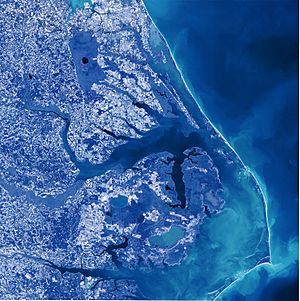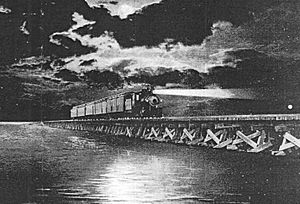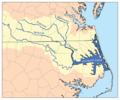Albemarle Sound facts for kids
The Albemarle Sound is a large body of water on the coast of North Carolina in the United States. It is an estuary, which means it's where fresh water from rivers mixes with salt water from the ocean. Rivers like the Chowan and Roanoke flow into it.
The sound is separated from the Atlantic Ocean by a thin strip of land called the Currituck Banks. This land acts like a natural wall, protecting the sound. The famous town of Kitty Hawk is located on this strip of land, which is part of the larger Outer Banks area. Roanoke Island is also nearby, connecting the Albemarle Sound to the Pamlico Sound. Because so much river water flows in, most of the water in Albemarle Sound is a mix of fresh and salty water, or even completely fresh.
Some smaller parts of the Albemarle Sound have their own names. For example, the Croatan Sound is between mainland Dare County and Roanoke Island. The water on the eastern side of Roanoke Island, near the Outer Banks, is often called the Roanoke Sound. Also, the long stretch of water from the Virginia state line down to Currituck County is known as the Currituck Sound.
The Albemarle Sound is part of the Atlantic Intracoastal Waterway. This is a long path of rivers, canals, and bays that ships can use to travel along the Atlantic coast. The first permanent English settlements in North Carolina were built along the shores of the Albemarle Sound. Many towns along the sound today are part of the Inner Banks region of the state.
Contents
History of Albemarle Sound
Before Europeans arrived, the Algonquian Indians lived around the Albemarle Sound. They used dugout canoes to travel on the water and caught fish for food.
In 1586, the first European explorers sailed along the 55-mile (88 km) length of the Albemarle Sound. About 50 years later, the first European settlers came south from Virginia. They started farms and trading posts along the sound's shores.
The Albemarle Sound quickly became a very important route for ships. Small trading ships, called coasters, carried goods between colonies. Larger merchant ships brought spices, silks, and sugars from the West Indies. In return, they took products like tobacco, herring, and lumber from the southern colonies.
In 1663, King Charles II of England made Albemarle Sound part of the Province of Carolina. He gave the land to eight special owners called Lords Proprietors. One of these owners was George Monck, 1st Duke of Albemarle, and the sound was named after him.
Traveling Across the Sound
Ferries were a common way to cross the swamps and waters around the Albemarle Sound for many years. One ferry that connected the towns of Edenton and Mackeys ran from 1734 until 1938. That's when a bridge was finally built across the sound. Another, even longer bridge, more than 3 miles (4.8 km) long, was built in 1990.
Fishing in the Sound
Fishing was a very important business in the Albemarle Sound. In late spring, farmers would fish for shad, striped bass, and herring. The nets they used were sometimes huge, over a mile (1.6 km) long! Fishermen often worked 24 hours a day.
Herring was cut and salted to be sent to Europe. Shad was packed in ice and shipped up the Chowan River to be sold in northern colonies. The area was also famous for its striped bass fishing tournaments. Many people thought it was the best place in the world to catch striped bass.
However, in recent years, water pollution and new buildings have caused the number of fish in the Albemarle Sound to drop by 70 percent.
Images for kids
See also
 In Spanish: Albemarle Sound para niños
In Spanish: Albemarle Sound para niños




